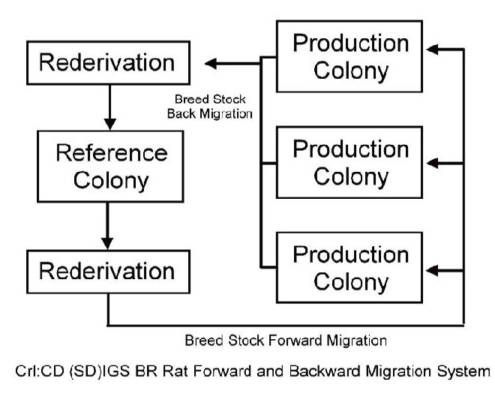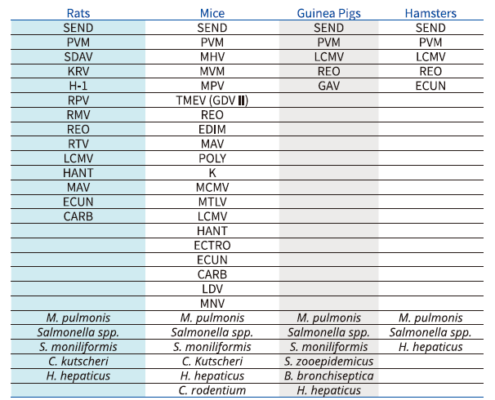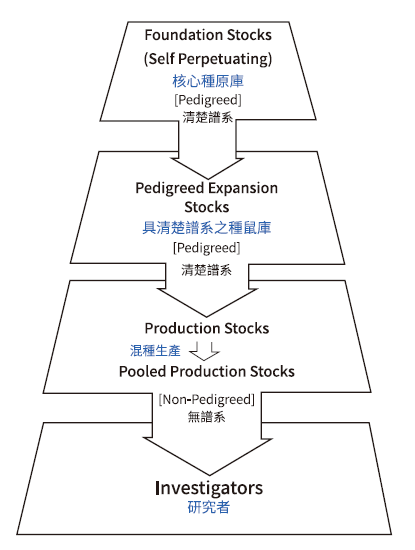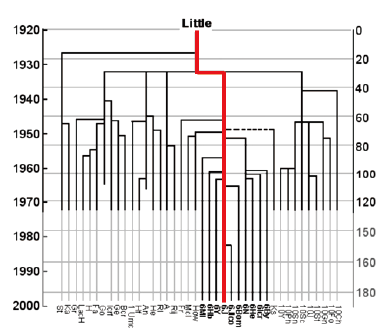繁殖系統基本概念
1950 年代 Charles River (CRL) 以帝王切開術方式改善 Crl:CD® (SD) 之微生物狀態,並於 1990 年代初在 8 個不同國家中使用 23 個生產群從事生產 CD 大鼠。1980 年代後期,CD 大鼠以及其他近交品系在內的商用大鼠同樣出現壽命縮短的趨勢,造成這樣變化的原因不明,但這似乎與隨機交配體系的未知性選擇壓力而導致遺傳結構改變有關,因此 CRL 決定再次驗證其育種的步驟,並建立綜合選交系統來減少不均性群體的選擇壓力;同時,隨著生物醫學研究的全球化,CRL 必須採取些步驟將全球 CD 大鼠族群一致化並減少族群間遺傳漂變引起的變異,因此制定了包括 CD 大鼠在內的遠交系大鼠全面育種程序的重組計畫。該計畫促使所有 CD 大鼠生產族群在遺傳上趨於一致,例如 Crl:CD® (SD) IGS BR 於 1994 年逐漸開始商業化生產,到 1998 年成為國際遺傳標準育種計畫群體。
何謂 IGS 繁殖系統?
IGS 並非實驗模式,而是應用於管理實驗動物的健康與控制遺傳背景之完整的系統。此系統包含四種基本要素:健康、遺傳背景、品質保證和操作程序的標準化。此系統可確保客戶於全球各地任何一個 CRL 繁殖地點所購買到的實驗動物,皆具相同的遺傳背景及生物特性。
IGS 繁殖系統主要的困難是如何創造一種機制,使不同地區的種群間差異達到
最小。種群間的動物移動是解決該問題的一種方式,這可保持不同種群遺傳的一致性,同時也能有效地控制遺傳變異
的發生。因此 CRL 將不同種群間的種鼠移動,選用其他生產群中有遺傳代表性的個體,組成生產商品動物的種群;當進行適當規模和頻率的移動時,會借助族群遺傳參數分析等,以基因頻率的分佈來決定是否移換。

VAF/Plus® (Virus Antibody Free) 無特定病原概念
美國 Charles River (CRL) 公司針對屏障系統所提出的概念。經過 50 多年的發展,已經成為全球最大實驗動物供應商。此概念符合科學研究應用的實際需要和屏障系統內動物繁殖育種的合理性,並且得到了美國 FDA 和全球的科學研究機構認可。
VAF/Plus® 動物是在嚴格控制下的屏障系統裡進行動物的維持與繁殖,這些動物通過頻繁的監測以確保他們沒有下表列舉的微生物感染。在動物身上也沒有特定的寄生蟲 (例如蟯蟲) 以及有潛在致病力或者對實驗結果有干擾的細菌。
VAF/Plus® 動物並非代表完全無菌的,而是他們已經能夠與科學研究環境中廣泛普遍存在有益的微生物和諧共存。
想了解更多 VAF/Plus® 動物訊息請上美國 CRL 網站 — http://www.criver.com

Genetic Quality Control Program 遺傳品質控管計劃
Our Genetic Quality Control (GQC) program is designed to detect and prevent the spread of genetic contamination.
- Rigorous breeding protocols
We limit the number of generations attained in our foundation and expansion stocks to less than 10generations from the main pedigree line.
We isolate foundation, expansion, and production stocks from each other.
We maintain detailed pedigrees of our foundation and expansion stocks.
We systematically refresh our production stocks with mice from foundation stocks.
We adhere to proven mouse husbandry practices. - Thorough systematic screens of all stocks for phenotypic variations, including coat color, body size, and behavior.
- SNP-genotyping
Between the 1960s and 2003, our GQC program used biochemical (isoenzyme) variants to distinguish among different strains of mice. In 2003, after extensive testing, we converted to single nucleotide polymorphisms (SNPs).
Although SNPs are the most abundant type of polymorphism, until the mouse genome was sequenced, few mouse SNPs were mapped or available in public databases. Additionally, the feasibility of using them as genetic markers had not been established. Dr. Petko Petkov and his colleagues (Petkov and Cassell et al., 2004; Petkov and Ding et al. 2004) of The Jackson Laboratory demonstrated that SNP-genotyping with a panel of only 28 carefully selected SNPs can distinguish between virtually all JAX Mice strains. The panel has the following advantages:
It is reliable, simple, quick, and inexpensive;
It is amenable to high throughput;
It is suitable for both large and small scale animal facilities; and it may be used to type mice before they are used as breeders. - Verification of mutant alleles in mutant stocks
Our molecular genotyping lab uses allele-specific assays, PCR-genotyping, and other assays to verify mutant genotypes of genetically engineered and cloned spontaneous mutations. Experienced technicians verify the visible phenotype of many spontaneous mutant colonies every one to two generations. - Phenotypic deviant search
The Mouse Mutant Resource phenotypic deviant search detects and prevents spontaneous mutations that cause visible phenotypes from becoming fixed in JAX inbred strains. Animal care technicians send mice from breeding units with deviant phenotypes to a bi-weekly clinic. Scientists determine which deviant phenotypes are likely caused by a mutation and test them for heritability. Breeding units with deviant mice are removed from the breeding colonies, and the parent strains are closely monitored to see if the phenotypes recur.
Genetic Stability Program 遺傳品質穩定計劃
Our Genetic Stability Program (GSP) is designed to limit genetic drift, a cumulative change in the genetic make-up of an organism over time. Genetic drift in inbred mouse colonies happens slowly, subtly, and is difficult to detect and control. It is caused by the same factors that lead to substrain divergence:
- Separation of a sub-colony from its parent colony for more than 20 generations (10 generations in the parent colony plus the ten that simultaneously pass in the sub- colony).
- Undetected spontaneous mutations that become fixed in a colony; and Residual heterozygosity in or incomplete inbreeding of a colony before it is separated from its progenitors (Bailey 1977, 1982).
- Following are eight examples of genetic drift: (8個遺傳漂變例子).
- At least 40 C57BL substrains develop between 1930 and 1970 (Fig. 2): although some of these substrains are due to deliberate outcrossing, most are probably due to maintaining colonies separate from the originating colony for more than 10 generation.
- Histocompatibility variants exist within A, AKR, BALB/c, CBA, C3H, C57BL, C57L, DBA, and WG strains (Bailey 1982).
- Substrains C57BL/6N, C57BL/6Nmg, and C57BL/6JKun are phenotypically different from each other and from the C57BL/6J founder line (Radulovic et al. 1998; Sluyter et al. 1999; Stiedl et al. 1999; Roth et al. 2002; Wotjak 2003).
- C57BL/6JOlaHsd, a substrain of C57BL/6J, has a spontaneous deletion in part of the alpha-synuclein gene (Specht et al. 2001; Wotjak 2003).
- A deletion of the killer cell lectin-like receptor, subfamily D, member 1 gene (Klrd1) on Chr 6 is identified in JAX® Mice strain DBA/2J (Wilhelm et al., 2003).
- A spontaneous deletion of two ion channel genes, Kcnq2 and Chrna4, in a C57BL/6J substrain generates a mouse model of epilepsy (Yang et al., 2003).
- The expression of a hippocampus specific protein differs between strains C57BL/6JNmg and C57BL/6Jkun (Sluyter et al., 1999).
- C3H/HeJ mice are homozygous for a paracentric inversion in Chr 6 (JAX NOTES
2003). “This insidious evolution of the inbred genotype is known as genetic drift. It is capable of subverting the conclusions reached about comparable research results coming from different laboratories when each uses its own subline of the same inbred strain.”(Bailey 1977)
To limit genetic drift in our mouse colonies, we implement a three-component Genetic Stability Program: - We minimize the number of generations attained in our foundation and production stocks (see GQC section).
- We use highly skilled and experienced technicians to oversee breeding in thosestocks (see GQC section).
- We use a unique cryopreservation approach to virtually stop genetic drift in the most commonly used inbred strains (see below).


